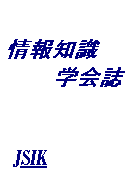
- |<
- <
- 1
- >
- >|
-
Koji WAJIMA, Toshihiro FURUKAWA, Tetsuji SATOHArticle type: research paper
2019Volume 29Issue 3 Pages 193-212
Published: October 15, 2019
Released on J-STAGE: November 15, 2019
JOURNAL FREE ACCESSThe social concern with communication between a consumer and maker has been growing for the last several years. A large number of unspecied users are investigating Consumer Generated Media's communication on the Internet. The claim has the tremendous impact on the purchasing behavior in Consumer Generated Media. This paper is intended as an investigation of signicant feature quantity for topic forecast. In this Paper, We investigate online media's topic forecast on Online Community article. We comprehensively extracted text information's feature quantity using existing research. Feature quantity is used, for 31 types and 2,071 dimensions in text information. Proposed Method consists of feature transformation and the base on evaluation using Nonnegative Matrix Factorization (NMF). The validity of the Proposed Method is veried by Support Vector Regression (SVR) and Classiers. It was found from the evaluative result that have an impact on view count. We report that research result.
View full abstractDownload PDF (3017K) -
Kai NISHIKAWAArticle type: research paper
2019Volume 29Issue 3 Pages 213-233
Published: October 15, 2019
Released on J-STAGE: November 15, 2019
JOURNAL FREE ACCESSThis paper aims to clarify the results to date of Ostrom and Hess’s research project, which was meant to systematize the study of knowledge commons, and lay the foundation on it. In this context, research on knowledge commons is intended as the study of shared knowledge resources, and the institutions for governing them. First, a systematic review focusing on 88 documents extracted from 4 databases such as ProQuest is conducted. The results indicate that the approach, which revises the methodology used in the study of the commons focusing on shared natural resources, is being established. Secondly, the implication of the concept “commons” in it is clarified, the position of it in the study of commons is reviewed, its future research direction is proposed.
View full abstractDownload PDF (1660K) -
Rumiko TANAKA, Shin-ichi NAKAYAMAArticle type: research paper
2019Volume 29Issue 3 Pages 238-246
Published: October 15, 2019
Released on J-STAGE: November 15, 2019
JOURNAL FREE ACCESSThe chemical substance names described have various descriptions and the description of the name depends on the author. Such variation causes hindering information sharing of chemical knowledge. Auto-extraction of chemical substance names is useful for information sharing. In order to find a method for extracting the names of chemical substances in Japanese documents, we created a corpus of patent documents tagged with chemical substance names. We studied cutting out words from sentences and recognized chemical substance names by concatenating cut-out words using the part of speech information. We also studied selecting chemical substance names from concatenated cut-out words and made a selection comparison between chemical substance names and functional group names that are similar to chemical substance names.
View full abstractDownload PDF (698K) -
Kazutoshi TANABE, Takahiro SUZUKIArticle type: research paper
2019Volume 29Issue 3 Pages 247-267
Published: October 15, 2019
Released on J-STAGE: November 15, 2019
JOURNAL FREE ACCESSSuicide, one of the most serious social problems in modern Japan, is known to be caused by many complex factors. Regional correlation study on local suicide rates and various affecting factors attracts much attention from the viewpoint of regional countermeasure for decreasing suicide rates. In this study, a statistical approach to get information on reasons of suicide in Japan has been carried out by searching key factors affecting suicide rates. A support regression method as a nonlinear regression procedure was applied to male and female suicide rates of 47 prefectures as dependent variables and 54 kinds of various regional factors as explanatory variables. Twelve determinants for each men and women, respectively, were obtained which reproduce the suicide rates of prefectures with a statistical significance level. Among those determinants, psychiatric social worker, household income, and patient rate for men, and consultation situation of trouble and stress, birthrate, and overtime for women dominantly affect suicide rates. New determinants not verified in previous studies, such as psychiatric social worker, overtime, and mental status contribute, while unemployment rate and divorce rate so far frequently verified do not contribute. A countermeasure for decreasing the suicide rate in Akita prefecture with the highest suicide rate in Japan, was proposed on the basis of values of determinants.
View full abstractDownload PDF (1050K) -
Sho SATO, Yuzuka ISHIBASHI, Ryoka MINAMIDANI, Mayu OKUDA, Ikuyo HOSHI, ...2019Volume 29Issue 3 Pages 268-283
Published: 2019
Released on J-STAGE: November 15, 2019
Advance online publication: July 19, 2019JOURNAL FREE ACCESSWe scored the “amuse” of titles of scholarly articles for non-academics and examined whether there was a difference in this score between articles mentioned in Twitter many times and those never mentioned. Twitter mention data were retrieved from Ceek.jp Altmetrics. Articles published in 2008 were chosen as the sample. Top 103 articles mentioned in Twitter and randomized 100 sample articles never mentioned in Twitter were analyzed. Four non-academics evaluated the “amuse” of each articles’ title by seven-scale, and the sum of the score defined as “Amuse Score.” The results showed that there was significant difference between the “Amuse Score” of articles mentioned in Twitter many times and those of articles never mentioned in Twitter. Titles of articles mentioned in Twitter many times were more “amusing” than those of articles never mentioned. This difference was confirmed independently of the field of the articles.
View full abstractDownload PDF (1421K) -
Niichi NISHIWAKI2019Volume 29Issue 3 Pages 284-289
Published: October 15, 2019
Released on J-STAGE: November 15, 2019
JOURNAL FREE ACCESSDownload PDF (708K)
- |<
- <
- 1
- >
- >|